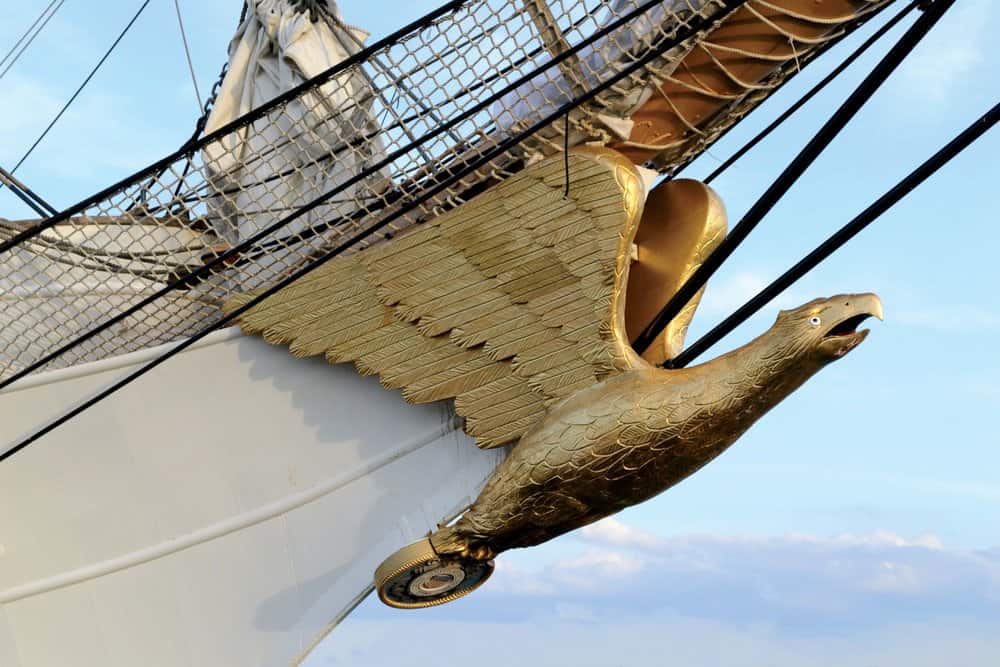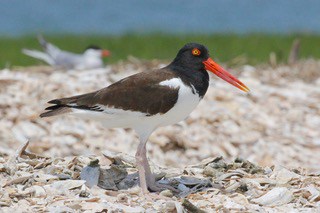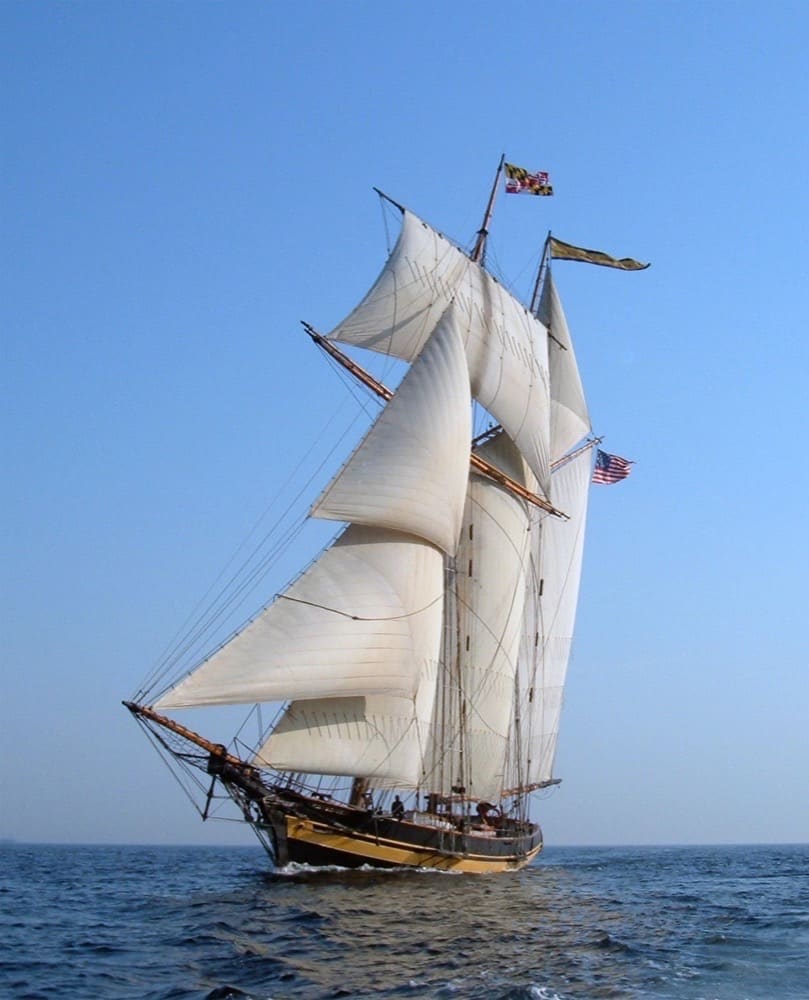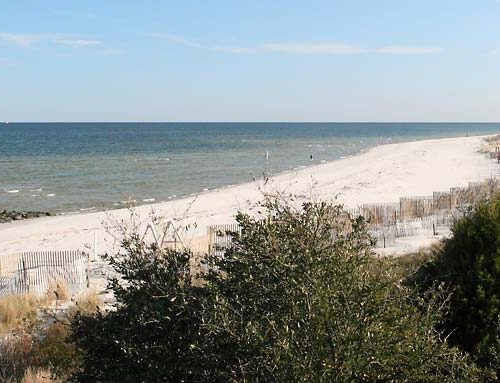story and photos by Karen Soule
The author joins America’s tall ship on a 330-nautical-mile sail test with the Deltaville sailmaker who built the Eagle’s new sails.
Photo by Karen Soule.“Sail stations, sail stations, all hands to sail stations,” the bosun’s mate barked, summoning her charges to the main mast of the Eagle on the first day of May and the beginning of the tall ship’s summer cruise. We were leaving Norfolk’s Joint Expeditionary Base in Little Creek on our way to New London, Connecticut. As we passed between Virginia’s capes and waved good-bye to the Chesapeake Bay, the sky was cerulean blue, and the wind blew steadily out of the southwest at 25 knots. The conditions were perfect for a shakedown cruise after a six-month refit layup in Baltimore, and ideal for a shakeout of Eagle’s new sails, which were built in a small sail loft in Deltaville, Virginia.
There were only fifty or so permanent crew on board to hear the sail station call on this run up to the Coast Guard Academy. But the blue-clad Coasties weren’t concerned about being short-handed as they cinched on their climbing harnesses and prepared to scamper up the ratlines to the upper reaches of the Eagle’s rig. After months in a Baltimore dry dock, the crew was eager to set sail. But first they had to train the ten friends-and-family crewmembers how to climb the 147-foot mast.
Of those guests, only the sailmaker, Ullman Sails Virginia loft manager Justin Ailsworth, was unafraid to go aloft. Ailsworth and his Deltaville-based team had just finished building a dozen new sails for the nation’s only active commissioned sailing vessel. (The USS Constitution based in Boston, is commissioned but not actively sailed.) For Ailsworth, climbing the mast and unfurling the Eagle’s main course, the largest and lowest of the square sails, was the high point of his sailmaking career—no pun intended. He had spent hundreds of hours over five months transforming thousands of yards of material into the Eagle’s billowing canvases. It was time to see his work take flight.
Ailsworth was not content to merely execute an up-and-over maneuver—climbing up the first set of windward shrouds and down the leeward ones like the other guests did. He wanted to inspect his handiwork firsthand and continued out onto the first horizontal spar to his sail. He clipped in his harness, placed his feet onto the rope strung beneath the 78-foot yard and prepared to untie the lines holding the main course fast to the spar.
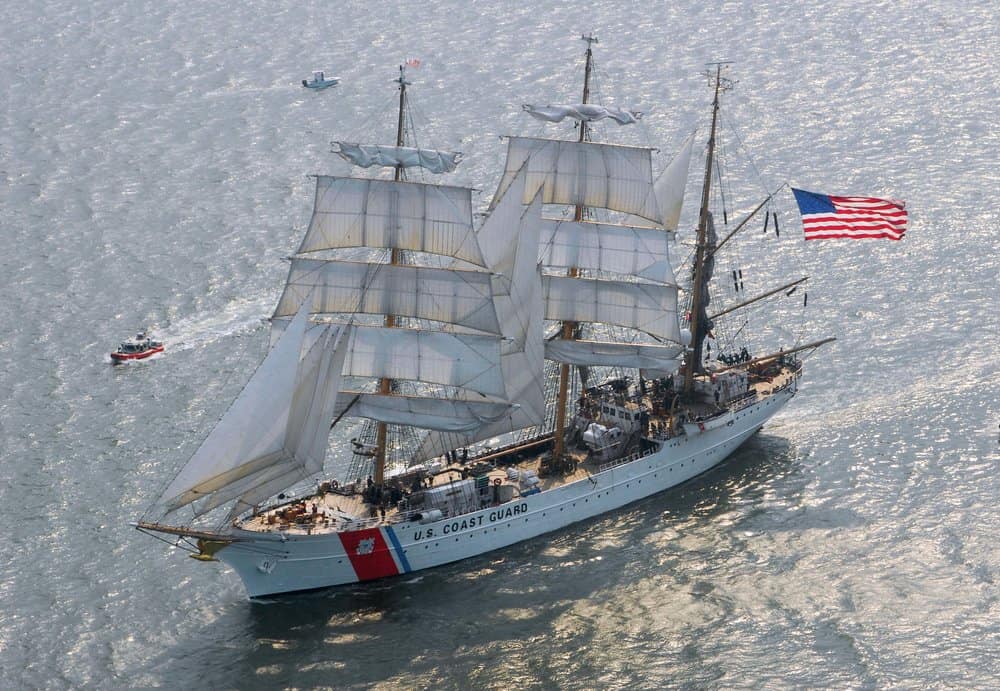
Ailsworth is a reserved, quiet guy and the son of a son of a Deltaville sailor. He is grateful he can do what he loves, building sails in the place where he grew up. His focus is steadfast. He’s not one to mince words. Along with the dozen or so Coasties who were laid out along the 6,000-pound yard like birds perched on a power line, Ailsworth awaited the commands to, “Loose the course. Sheet home.”
The crew aloft released the canvas, and those on deck trimmed the sheets. The sail took shape and the Eagle leapt forward. The sailmaker, a man in his element, smiled.
And so, the crew and guests of the Eagle deployed 10 out of a possible 23 sails. Any more wasn’t feasible with so few hands on board. In New London, 130 cadets would come aboard, or “cross the brow,” as they say, nearly quadrupling the crew’s size and the number of meals cooked and consumed. Captain Matt Meilstrup, the Eagle’s Commanding Officer, announced that this was the first time they had “set her squares” while so shorthanded. The Eagle’s speed crept over 10 knots and the powerful diesel went silent. The ship encountered six- to eight-foot seas, dense fog, rain, and winds topping 30 knots, none of which is of concern for an 1,800-ton vessel. Not wanting to arrive in New London in the black of night, the crew shortened sail at 1950 hours that first day. She dropped down to only six knots and would later approach Connecticut in only two-days’ time.
Throughout the trip, crewmembers were eager to show their guests the ropes, and everyone took a turn at the helm, hauled on the halyards and polished tons of brass to the tunes of the Steve Miller Band. No, they didn’t play “Fly Like an Eagle,” but this Eagle sure did. It was magical. The father of one enlisted cutterman said, “A trip on the Eagle was such an unthinkable dream, it wasn’t even on my bucket list.”
A Bit About the Eagle
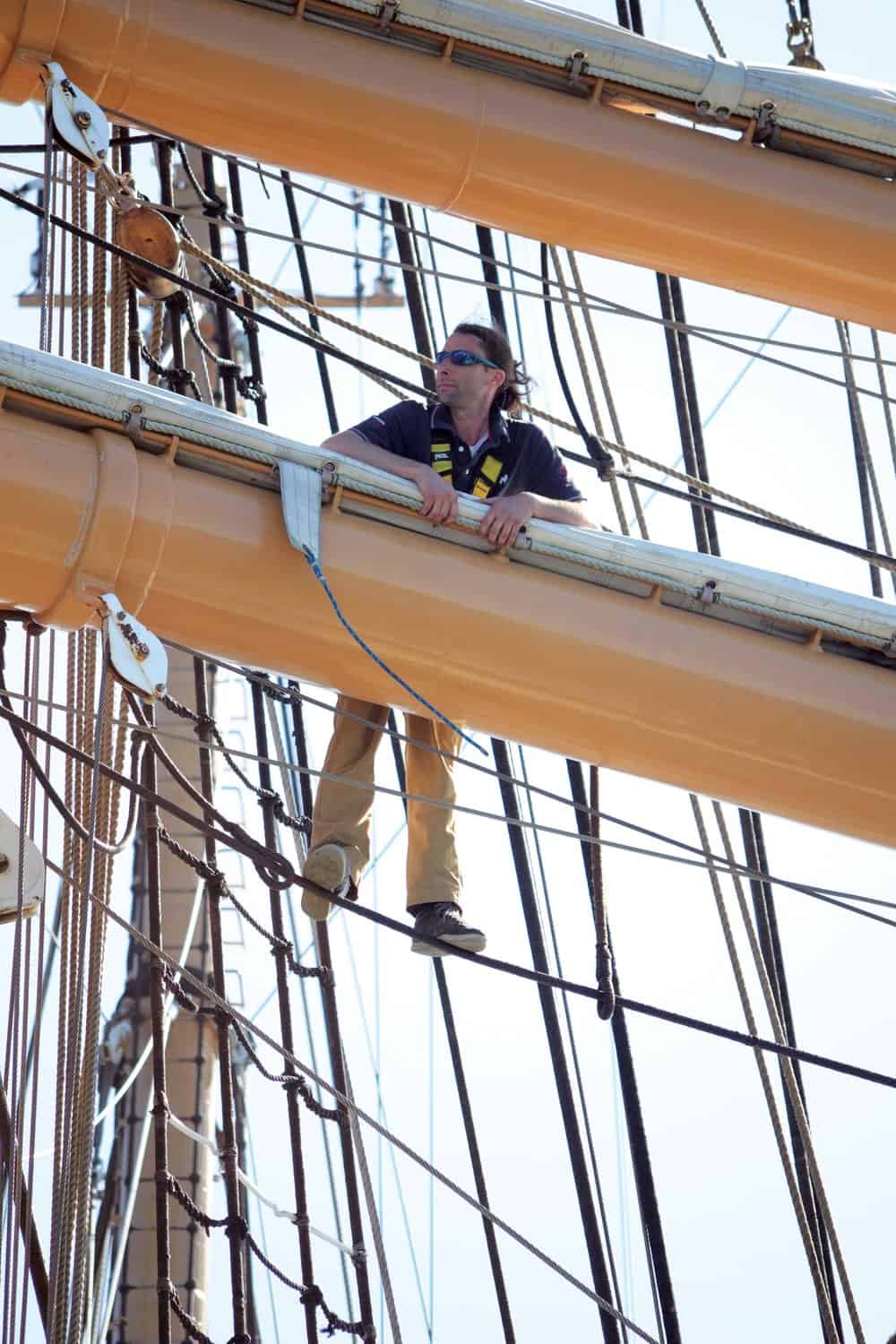
To appreciate the size and scale of the task that faced Ailsworth and the other sailmakers, it’s helpful to have a little background on the ship. Originally named the Horst Wessel, she’s an 80-year old, steel-hulled vessel once used as a Nazi training platform. The U.S. Coast Guard acquired her following World War II. She has three masts. The fore and main masts are square-rigged and stand 147.3 feet tall. The gaff-rigged mizzen mast stands 132 feet. This configuration makes her a barque. There are more than six miles of running and standing rigging controlling 22,300 square feet of sail. Under power, a 1,000-hp Caterpillar engine helps her top ten knots. Under sail she can achieve up to 17 knots when conditions allow.
The Eagle is the Coast Guard’s sailing ambassador, and when in port, she is open to the public. Her primary mission is to train future Coast Guard officers. There’s nothing like learning how to direct a crew when dangling from a harness 130 feet up in the air. Each summer, rotating groups of cadets and officer candidates spend five weeks sailing to various ports of call while learning the difference between a lizard, a buntline and a bumpkin. The 2017 cruise included stops in Bermuda, Cape Canaveral, Norfolk, Boston, New York, Halifax, Quebec City, Prince Edward Island and Baltimore. A two-year assignment to the Eagle is such a plum billet (assignment) that Coasties have to apply or be invited to serve.
Back at the Loft
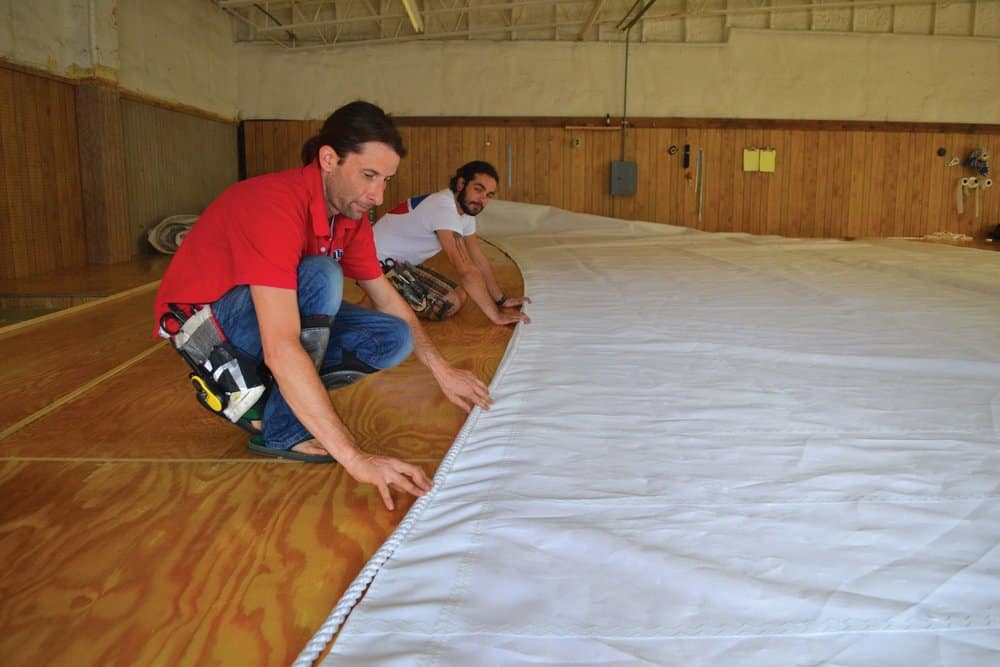
Building a dozen new sails for the Eagle was a monumental task and an honor. “We’re one of the few sailmakers left, anywhere, that had the knowledge and people needed to do the job,” explains loft owner Jerry Latell. “Justin [Ailsworth] had helped build a few sails for the Eagle before, so I knew he was the right person to put in charge of this project.”
Today, many modern sails are made overseas in China or South Africa using sophisticated design and manufacturing methods. Latell’s team also designs high-tech sails integrating computer-generated models and cutting instructions, which are then fed to a 30-foot-long computer controlled cutting machine, which cuts the sail panels. Building sails for the square-rigged barque required a different approach. Ailsworth consulted Nathaniel Wilson, a legendary traditional sailmaker in East Boothbay, Maine. He also had hands-on training from Stuart Hopkins of Dabbler Sails on Virginia’s Northern Neck, another traditional crafter of dinghy and smaller sails. “And I read and experimented,” he says.
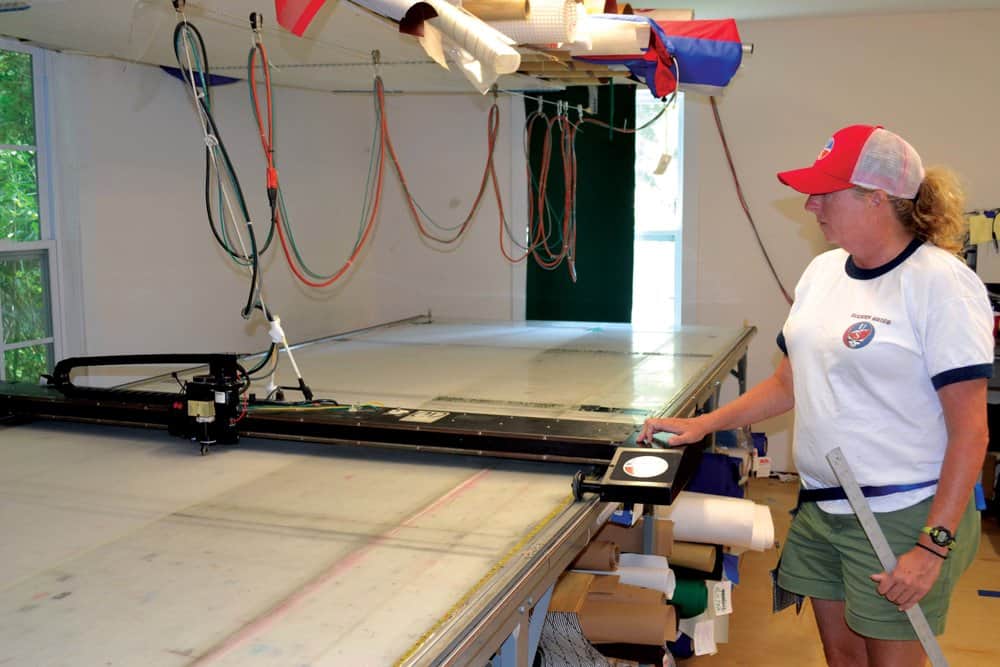
The first step in the process was to measure the old, worn-out sails. The main course sail measured 28 by 73 feet, too large for the loft’s floor. So Latell worked out a way to use the local elementary school gym floor whenever it was available. They used the basketball court sidelines as a starting point, marked the sail’s corners and ran blue painter’s tape on the gym floor to outline its dimensions. They rolled out 18-inch wide Dacron sail cloth back and forth within those tapes and added about a foot of material to each side for the sail’s borders, for the “tabling” edges. After cutting the panels, they marked and rolled them up, and returned them to the loft for sewing. Ailsworth says that, unlike many modern sails, where the load of force is horizontal, the panels of a square sail are vertical and the load is along the foot of the sail. “The tremendous force on these sails is very humbling,” he adds.
Back at the loft, sailmaker Melanie Tennant sewed the panels together. Seated in her sewing machine pit, which positions the machine level with the loft floor with her head barely peeking above the floor, she stitched each panel together in groups of three, and sewed those groups together, and so on. In the end, the sails might look square, but the bottoms, or foots, are curved in a shape called a “hollow” and the heads are rounded, which gives shape to the sails when strapped to the yard arms, booms and gaffs. It’s important to keep each panel in the correct order. Once the panels were together, the workers rechecked all the dimensions on the loft floor. Next, the sailmakers attached the tabling, added patches to reinforce the corners and sewed on UV covers.
Joining the panels together went rather quickly. The next stage was where the painstaking detail work took place. Jake Pender, another member of the loft crew, made grommets out of rope, attached scores of clew-irons, which are metal fittings to facilitate sail changes, and head-earrings, which are spliced to the head cringles for securing a square sail to the yard arm, and he sewed on leather reinforcing patches, all by hand.
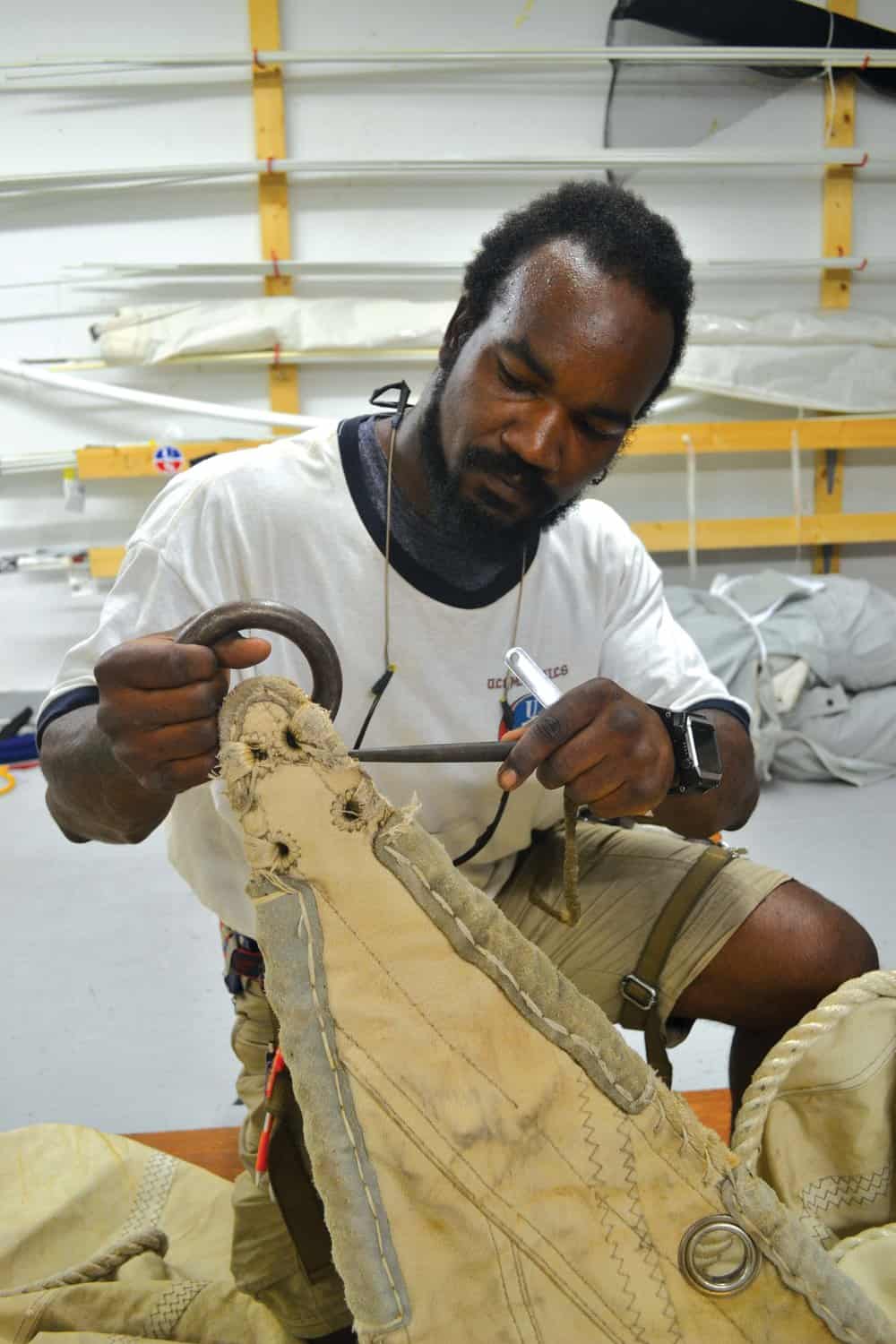
But it’s the bolt-rope, a one-inch line sewn around the edge of the sail, that really differentiates traditional sails from modern ones. “If you think of a square sail as a picture,” explains Latell, “the bolt-rope is its frame.” Ailsworth estimates that he drove a needle almost the size of an ice pick into the rope and through the edges of the new sails 33,000 times. This work requires tremendous patience, focus, strong hands, nimble fingers and hours of good music to “just keep sewing.”
The Sailmaster Bosun Erin Stapleton, the ship’s sailmaster, is deeply invested in the new sails. The sailmaster is responsible for all operations from the main deck up. Therefore, he worked closely with the Deltaville team to ensure all sail specifications and details were pinpoint accurate. “My previous assignment was running a station in Maui,” he says. “It was nice, but this post is better.”
Stapleton served on the Eagle for two years and was on the 2016 cruise to Ireland and England. “We had weeks of high winds and heavy seas,” he recalls. “We ate and slept on the floor of the wardroom. This short trip to Connecticut was easy compared to that.” Unlike modern sailboats, square riggers hardly sail higher than a broad reach, about 70 degrees off the wind at best. But on this trip north, the Eagle didn’t need to point. The winds and the stars were perfectly aligned for a downwind run up the coast.
His two-year tour aboard the Eagle ended this summer. He is now running a Coast Guard station in Portsmouth, Va. “Last year when we were in dry dock in Baltimore, I only saw my family on the weekends,” he explains. “I’ll miss the Eagle, but I’m glad to be leaving her with a new suit of sails.”
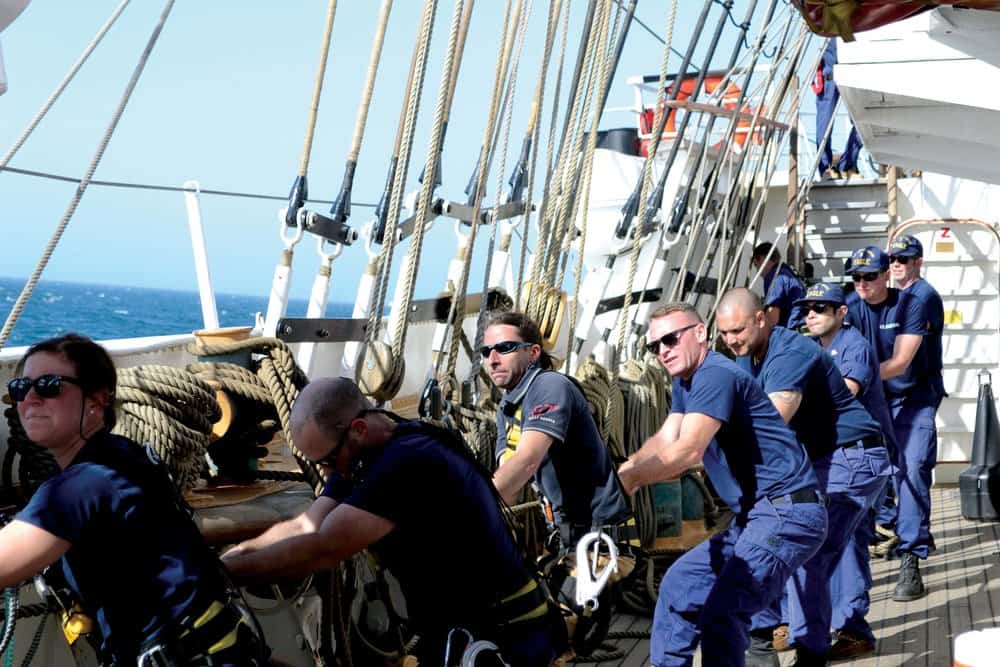
And Now The Eagle’s 2017 cruises ended with a return to Baltimore in September where she entered dry dock to complete her multi-year, $28 million refit including repowering with a new, German-built diesel engine. Over the summer, hundreds of cadets learned to distinguish a Flemish horse (footrope running the length of a yard) from the futtocks (links in the rigging that carry the load of the shrouds). They heaved-ho on the halyards and sometimes heaved over the rails before returning to classes at the Coast Guard Academy.
As for her current canvas, there remain four that the sailmakers in Deltaville haven’t yet replaced. Ailsworth is back building racing jibs and repairing cruising mainsails. Ailsworth fondly remembers his time aloft on the Eagle. “I couldn’t fully appreciate how the sails would look or how it would feel to see them flying until I got on board,” he explains, the smile still on his face. “It’s the most rewarding project I’ve ever done.”
To Learn More:
Follow the Eagle on Facebook or visit the Coast Guard Academy’s website at www.cga.edu.
View how-to videos on traditional sailmaking by Nathaniel Wilson at www.offcenterharbor.com.
Read The Skipper & the Eagle by Gordon McGowan, the Eagle’s first American captain.
Stop by Jerry Latell’s sail loft in Deltaville or visit latellsails.com.

